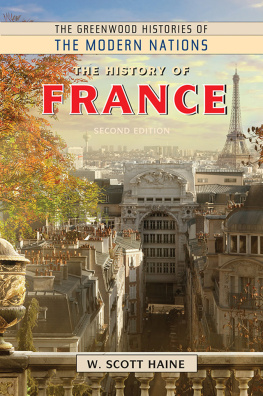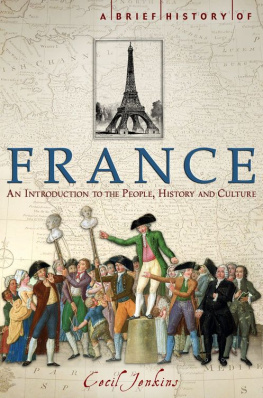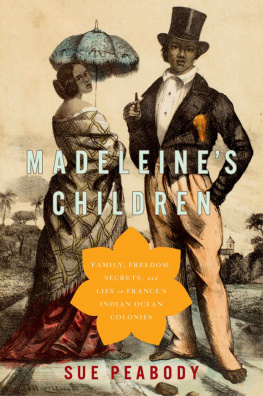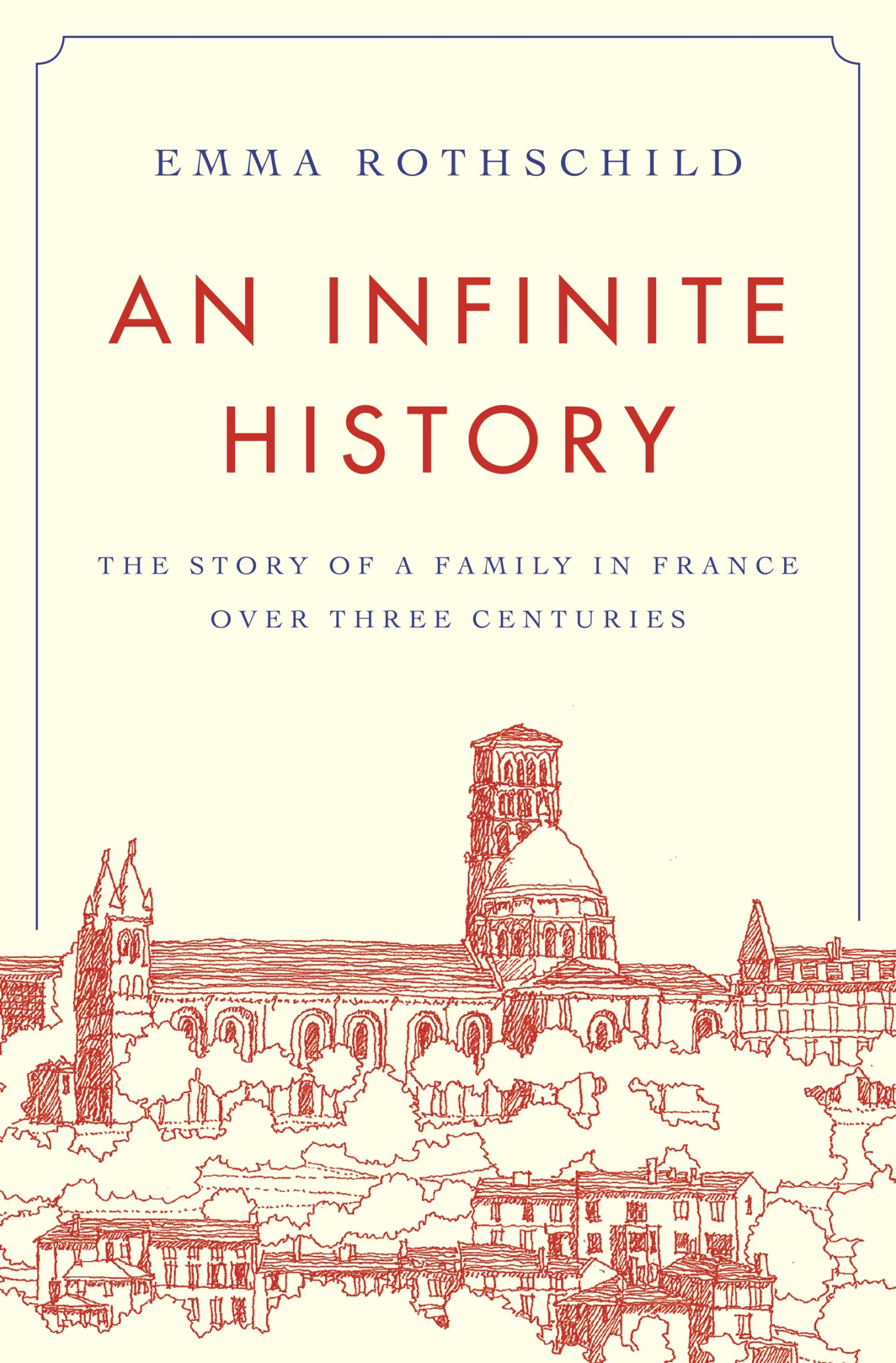AN INFINITE HISTORY
AN INFINITE HISTORY
THE STORY OF A FAMILY IN FRANCE OVER THREE CENTURIES

EMMA ROTHSCHILD
PRINCETON UNIVERSITY PRESS
PRINCETON & OXFORD
Copyright 2021 by Emma Rothschild
Princeton University Press is committed to the protection of copyright and the intellectual property our authors entrust to us. Copyright promotes the progress and integrity of knowledge. Thank you for supporting free speech and the global exchange of ideas by purchasing an authorized edition of this book. If you wish to reproduce or distribute any part of it in any form, please obtain permission.
Requests for permission to reproduce material from this work should be sent to permissions@press.princeton.edu
Published by Princeton University Press
41 William Street, Princeton, New Jersey 08540
6 Oxford Street, Woodstock, Oxfordshire OX20 1TR
press.princeton.edu
All Rights Reserved
Library of Congress Cataloging-in-Publication Data
Names: Rothschild, Emma, 1948 author.
Title: An infinite history : the story of a family in France over three centuries / Emma Rothschild.
Other titles: Story of a family in France over three centuries
Description: Princeton : Princeton University Press, [2021] | Includes bibliographical references and index.
Identifiers: LCCN 2020017235 (print) | LCCN 2020017236 (ebook) | ISBN 9780691200309 (hardback) | ISBN 9780691208176 (ebook)
Subjects: LCSH: Farrand family. | Aymard, Marie, 1713-1790. | Aymard, Marie, 17131790Family. | FranceGenealogy. | Angoulme (France)History.
Classification: LCC CS599 .F314 2021 (print) | LCC CS599 (ebook) | DDC 929.20944dc23
LC record available at https://lccn.loc.gov/2020017235
LC ebook record available at https://lccn.loc.gov/2020017236
Version 1.0
British Library Cataloging-in-Publication Data is available
Editorial: Priya Nelson and Thalia Leaf
Production Editorial: Lauren Lepow
Text Design: Leslie Flis
Jacket Design: Karl Spurzem
Production: Danielle Amatucci
Publicity: Alyssa Sanford and Kate Farquhar-Thomson
Jacket illustration by Sean ORourke
To Kate and to the memory of Iris
CONTENTS
AN INFINITE HISTORY
INTRODUCTION
The Ebb and Flow of Existence
This is a history of three or four thousand people, who lived in agitated times. It is a storyor ninety-eight storiesabout a small town, and an inquisitive, illiterate woman, Marie Aymard, who lived there throughout her life. It is the story, too, of an extended family over space, and over the historical time of the eighteenth and nineteenth centuries: Marie Aymards family, over five generations, and over the course of their unlikely lives, ending with the death of her great-great-granddaughter in 1906. It is an inquiry into the changing possibilities of historical investigation in our own times, and into the infinity of sources or evidence about past lives.
The small town is Angoulme, in southwest France, and in Marie Aymards lifetime it was known as a place of disquiet, introversion, and endless legal-financial affairs.
The history begins in the winter of 1764, with two pieces of paper. One was a power of attorney to which Marie Aymard attested, as part of her researchesin her own expressioninto the fate of her late husband, a carpenter who emigrated to the island of Grenada, and who had become the owner, or so she had heard, of a certain quantity of Negroes. The other was a prenuptial contract that was signed a few weeks later by eighty-three people in Angoulme, on the occasion of the marriage of Marie Aymards daughter to the son of a tailor.
The familys lives take unanticipated turns, and so do the stories of their acquaintances and neighbors; this is a history in the spirit of the gazza ladra, the thieving magpie who flies away with teaspoons and plates and shiny new coins. It is infinite, or incipiently infinite, in that there is no end to the information, diversions, and episodes of ordinary life. It is about contiguity in space, and in the space of social relationships; the inquiry starts with Marie Aymards family, with the larger social network of the eighty-three signatories of the marriage contract of 1764, and with the even larger society of the 4,089 individuals who were there in the parish registers of the town in the same year. It is also about contiguity in time, and the overlapping generations of family life, as the story continues into the eventful historical time of the French Revolution, and of the economic changes of the nineteenth century. It is inspired by an interest in other peoples livesin what happened next, and what it meantand by an exhilarated, exhausted sense of the possibilities of historical inquiry.
The history of Marie Aymard and her family is a journey in space and time, and it is also my own journey. I happened to go into a bookshop in Florence in the summer of 1980, and happened to see a history journal, Quaderni Storici, with an articleCarlo Ginzburg and Carlo Ponis manifesto of a prosopography from below, or of a history that is full of individuals and stories, and is not of necessity a history of the great and the celebratedthat made me wish I could be a historian. Fifteen years laterin Angoulme, near the railway station, in the unromantic setting of the Archives dpartementales de la CharenteI was captivated by archives, and have never wanted for a moment to lose the spell.
The technology of doing history has changed almost beyond recognition over the forty years since 1980, and that, too, is part of the story of this book. I have been lingering in the virtual space of the website of the Archives municipales dAngoulme, or being distracted, on 795 different days since the spring of 2012, and have 1,348 pages of images of my handwritten notes. But the sense of touching the history of individual lives is still there, and the sense of infinite possibilities. It is joyous to lose oneself in such a sea; e il naufragar m dolce in questo mare.
This is a history that has been an encounter, throughout, with novelists and the novel. It is a sequence of incomplete stories, like A Sentimental Journey, Laurence Sternes novel without an ending; one of the ninety-eight stories is about the little spotted dog of Sternes daughter Lydia, which was stolen on a quiet street in Angoulme in 1769. The most poignant events of Les illusions perdues were set on the corner of the same street, where six of Marie Aymards granddaughters were living in 1837. The lives of the nineteenth-century family are a history, like Emile Zolas own great human comedy, the Rougon-Macquart, of the children and grandchildren of a matriarch in an apparently isolated provincial town, who made their way, over five generations, to the distant corners of France.
But An Infinite History is a story that is without a sense of destiny, or of the development of character over time. It is flat and positivist, as in the naturalist novel, in Zolas description; an exact study of facts and things. It is important, in our own times, to observe the conversations and silences in the streets: to look around, now, and to see everyone, essentially without exception, telling stories and looking at images and sending messages, and to ask, How would it be if everything had always been like this?
It was the marriage contract of Marie Aymards daughter in 1764, even more than the power of attorney, that was the point of no return for the historical journey, and for the book. There has been something endlessly distracting about the occasion and the names. Over the two pages of the signatures, there are different inks and different flourishes, childrens names (Rosemarin) and imposing names (Marchais de la Chapelle), names that are crowded together and names that are impossible to read; it is as though the eighty-three signatures arise from their place on the page. Every single piece has a principle of motion of its own, as Adam Smith wrote of the game of human society.











